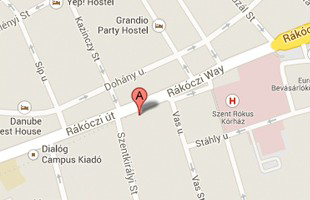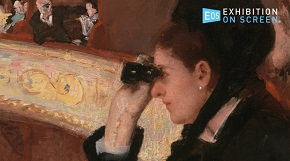Maledetto Modigliani
Italian biography, 98 min, 2020
in original language with Hungarian subtitles
Director: Valeria Parisi
To mark the celebrations of the 100th anniversary of Modigliani's death, is the documentary film Maverick Modigliani, that explores the life and work of Amedeo Modigliani (1884-1920), an avant-garde painter who became a classic contemporary artist loved and imitated all over the world.
Born in Livorno, Tuscany, Dedo or Modì, as the artist was often nicknamed, lived a short, tormented life, narrated here from an original point of view, that of his young common-law wife, Jeanne Hébuterne, who committed suicide two days after his death at the Hôpital de la Charité in Paris on 24th January 1920. Jeanne was pregnant at the time and left a one-year-old daughter. The documentary feature opens with the character of Jeanne and a reading of a passage from "Les Chants de Maldoror", a book Modigliani always kept with him. The action of the film unwinds through museum halls, enriched by the art works of the Albertina in Vienna and "Modigliani and the Adventure of Montparnasse", the splendid exhibition dedicated to the artist at Livorno’s City Museum, as well as the National Gallery of Art in Washington and the great museums and art collections in Paris.
Understanding Modigliani, the fourth son of a family of Jewish origin on the verge of financial crisis, means starting from his hometown Livorno, in an Italian province that made him feel caged in from the outset. Modigliani decided to leave and go in search of something else. He went to Florence, then Venice and arrived in Paris in 1906, aged 21. It seemed like the right place. This was where the legend of Modigliani - womanizer, alcoholic, tragic artist - was born. In reality, he was a man masking an illness, clinging to life and to his art. There was a truth he had to convey: universal values enclosed in the simplicity of lines and faces that make him one of the greatest exponents of the early twentieth century, and a classic in the twenty-first century.
In this documentary film the paintings themselves speak to us, filmed in dedicated sets from "La Filette en Bleu" to the portrait of Jeanne Hébuterne. Striking a fine balance between footage of the city as it is today and black and white photos and archive footage as it was then, Jeanne's narrative voice talks to us about Paris at the turn of the century: the ville lumière, the metropolis, the centre of modernity. It was an already established art market and a magnet attracting, from all over Europe, painters and sculptors that were going hungry then, only to be worth millions today, first and foremost Modigliani himself. Moving from one makeshift lodging to the next, Amedeo Modigliani, poor, hungry, but full of enthusiasm, met an aspiring poetess, the twenty-year-old Russian, Anna Achmatova, and the English journalist and feminist Beatrice Hastings. These were the women he painted portraits of, and whose faces, almost caryatid-like, became the very icons of his art. Something he had in common with Pablo Picasso, Constantin Brancusi and many others, was what lay on the horizon of his imagination – primitivism: an interest in non-European and ancient cultures, other places in space and time where avant-garde artists sought a return to nature, threatened by modernity. Modigliani’s interpretation of primitivism was, however, unique, in that he merged it with classical and Renaissance tradition.
This documentary film retraces the artist’s steps through the places he frequented the most: streets, squares, the Venezia Nuova district in Livorno, the synagogue, the central market, all the places in the mountains and the countryside where he learnt his craft with the Macchiaioli painters, and where he would find the sandstone and marble for his statues. We then get to discover Modigliani by comparisons made between his work and the work of other contemporary artists, above all Brancusi and Picasso and their work and art spaces (the Atelier Brancusi at the Centre Pompidou and the Musée Picasso in Paris). Another painter that was part of the ‘École de Paris’ movement was Soutine, a fellow Jew, with whom for a period of time he shared a studio-cum-home, that has remained unchanged to this day. We also find Modigliani at the Café de la Rotonde where Jean Cocteau captured his presence forever on the "terrace" along with Picasso, André Salmon and Max Jacob. Once again, we find traces of Modigliani in the Paris of today: wandering at night down the steps of Montmartre towards Montparnasse, the new place for people to meet and gather socially, walking around the Pantheon, and the closed gates of the Jardins du Luxembourg. Then we have the fantastic carriages of the Nuit Blanche, Paris’ all-night arts festival, representing the possible hallucinations caused by drugs and drink - hashish, opium and absinthe – that open up the doors of vision. Then there are his art dealers and collectors: Paul Alexandre, doctor and patron of the arts; Paul Guillaume, the ‘dandy parvenu’ whose portrait was painted several times; Léopold Zborowski, Modigliani's last art dealer, an adventurous poet, who - thanks to his acquaintance with the art collector Jonas Netter – was able to guarantee him a small monthly salary.
Modigliani, however, would die poor and unrecognized. Only later did he become one of the most highly rated artists in the world. And one of the most copied. His style seems easy, but only in appearance. We discover him at the free port of Geneva, in the workshop of Marc Restellini, one of the world's leading experts on Modigliani. And then in London, amid art fairs and in the studio of an artist who is a declared forger and now openly signs his imitation works, while only a few decades ago - in 1984, 100 years after the artist's birth - the carved heads fished out of the canals in Livorno shocked the world as one of the greatest hoaxes in the history of art.
Distributor: Pannonia Entertainment
It Takes Two to Tango (16)
TicketsCall Us17:30 Törőcsik Mari teremA legbelsőbb Ázsia - Magyarok nyomában Mongolországban (12)
TicketsCall Us17:30 Fábri teremRodrigue in Love (16)
TicketsCall Us18:00 Csortos teremThe Phoenician Scheme (16)
TicketsCall Us19:00 DíszteremHow Could I Live Without You? (12)
TicketsCall Us19:30 Fábri teremA House on Fire (16)
TicketsCall Us19:30 Törőcsik Mari teremDiamanti (16)
TicketsCall Us20:00 Csortos teremGaucho Gaucho (12)
![]()
2025.08.03 19:00 - 21:30
2025.08.08 19:00 - 21:00
2025.08.09 19:00 - 21:00
2025.08.10 18:00 - 21:30
2025.08.13 19:00 - 21:00
2025.08.16 19:00 - 22:00
2025.08.24 18:00 - 21:30
2025.09.14 18:00 - 20:00
09.16 - 09.21

Opening hours: Summer opening hours from June 26 to August 28, 2025! During this period, the box office opens on weekdays at 4:30 PM, on weekends at 10:30 AM.
Box office closes 15 minutes after the start of the last screening.
The Uránia Café is open during the opening hours of the cinema.
© Uránia Nemzeti Filmszínház
1088 Budapest, Rákóczi út 21.
getting here
ticket info
contact us
company details
press
privacy policy









